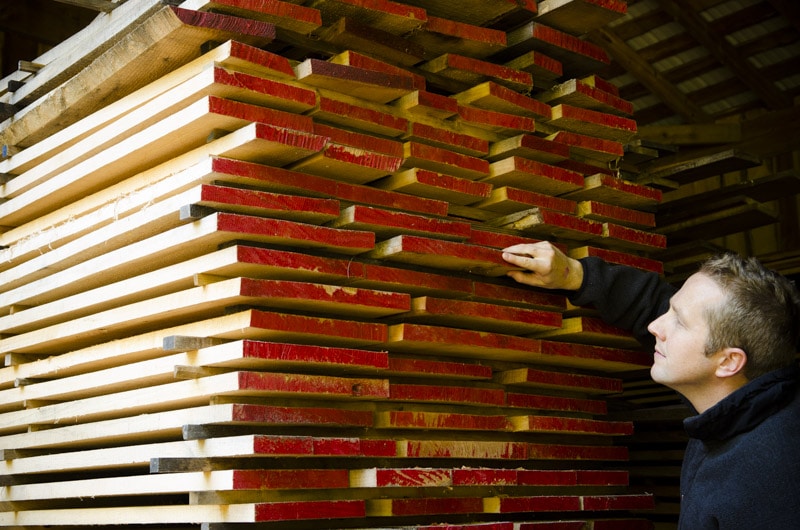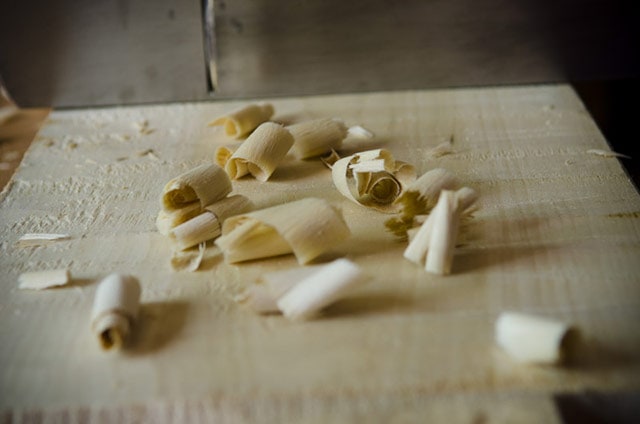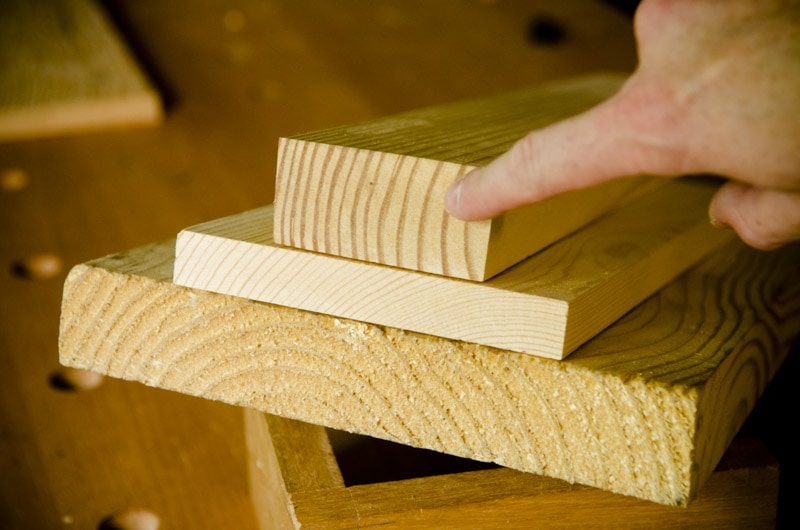
Types of Wood for Woodworking
By Joshua Farnsworth
Understanding different types of wood is really important for woodworker and furniture makers. It is unreasonable for woodworkers to learn every type of wood as there are hundreds of wood species, so below I have listed some of the most common types of wood lumber species that woodworkers use for making furniture and woodworking hand tools. Keep in mind that there are quite a few variations of different types of wood (e.g. hard maple vs. soft maple or Black Walnut vs. English Walnut) so I’m just listing the basic names:

Common Types of Wood: Hardwoods
- Alder
- Ash
- Beech
- Birch
- Butternut
- Cherry
- Chestnut
- Cypress
- Hickory
- Holly
- Mahogany
- Maple
- Red Oak
- White Oak
- Poplar
- Purpleheart
- Sapele
- Teak
- Walnut
Common Types of Wood: Softwoods
- Cedar
- Eastern White Pine
- Fir
- Redwood
- Spruce
- Southern Yellow Pine
What is the Best Wood for Woodworking?
As a furniture maker, some of my most favorite types of wood to work with (especially when woodworking hand tools) are black walnut, quartersawn white oak, cherry, beech, poplar, eastern white pine, and southern yellow pine. I use a lot of Southern Yellow pine because you can get it at most hardware stores as construction lumber, and if the boards are 10-12 inches wide, you can cut out the center and use the quartersawn pieces on the edges (see my other page for more details). Different types of wood are good for different purposes when building furniture, so it’s important to research what is the best wood for furniture projects that you’re building. For example, when building a chest of drawers, a primary (expensive) hardwood like cherry or white oak would be great for the exterior and visible parts and pine or poplar would work well for interior parts that most people won’t see often.

Free Resources to help you understand lumber for woodworking:
You can read my popular article: “Learn How to Choose Stable, Strong & Beautiful Wood”
Here is an excellent resource, with photos, of different types of wood: The Wood Database.
Janka Wood Hardness Test Chart
Below you will see a list of most of the different types of wood on a Janka hardness test chart. The Janka hardness test measures the force (pounds-force is abbreviated “lbf) required to push a small steel ball halfway into a piece of wood. Most of the types of wood below lead to a Wikipedia article that will teach you more about each type of type of wood:
| Force | Species |
| 5,060 lbf | Australian Buloke |
| 4,800 lbf | Schinopsis brasiliensis, Quebracho, Barauna, Chamacoco |
| 4,570 lbf | Schinopsis balansae, Quebracho Colorado, Red Quebracho |
| 4,500 lbf | Lignum vitae, Guayacan, Pockenholz |
| 3,840 lbf | Piptadenia Macrocarpa, Curupay, Angico Preto, Brazilian Tiger Mahogany |
| 3,800 lbf | Snakewood, Letterhout, Piratinera Guinensis |
| 3,700 lbf | Brazilian Olivewood |
| 3,692 lbf | Brazilian Ebony |
| 3,684 lbf | Ipê, Brazilian Walnut, Lapacho |
| 3,680 lbf | African Pearwood, Moabi |
| 3,664 lbf | Grey Ironbark |
| 3,650 lbf | Bolivian Cherry |
| 3,640 lbf | Lapacho |
| 3,540 lbf | Cumaru, Brazilian Teak |
| 3,417 lbf | Sucupira, Brazilian Chestnut, Tiete Chestnut |
| 3,260 lbf | Ironwood |
| 3,220 lbf | Ebony |
| 3,190 lbf | Massaranduba, Brazilian Redwood, Paraju |
| 3,040 lbf | Yvyraro |
| 3,000 lbf | Strand Woven Bamboo |
| 2,960 lbf | Cocobolo |
| 2,900 lbf | Bloodwood |
| 2,697 lbf | Red Mahogany, Turpentine |
| 2,680 lbf | Live Oak |
| 2,670 lbf | Southern Chestnut |
| 2,473 lbf | Spotted Gum |
| 2,350 lbf | Brazilian Cherry, Jatoba |
| 2,345 lbf | Mesquite |
| 2,330 lbf | Golden Teak |
| 2,240 lbf | Guatambú, Kyrandy, Balfourodendron riedelianum |
| 2,200 lbf | Santos Mahogany, Bocote, Cabreuva, Honduran Rosewood |
| 2,170 lbf | Pradoo |
| 2,160 lbf | Brazilian Koa |
| 2,135 lbf | Brushbox |
| 2,040 lbf | Osage Orange |
| 2,030 lbf | Karri |
| 2,023 lbf | Sydney Blue Gum |
| 1,980 lbf | Bubinga |
| 1,940 lbf | Cameron |
| 1,933 lbf | Tallowwood |
| 1,925 lbf | Merbau |
| 1,912 lbf | Amendoim |
| 1,910 lbf | Jarrah |
| 1,860 lbf | Purpleheart |
| 1,850 lbf | Goncalo Alves, Tigerwood |
| 1,820 lbf | Hickory, Pecan, Satinwood |
| 1,810 lbf | Afzelia, Doussie, Australian Wormy Chestnut |
| 1,798 lbf | Bangkirai |
| 1,780 lbf | Rosewood |
| 1,725 lbf | African Padauk |
| 1,720 lbf | Blackwood |
| 1,712 lbf | Merbau |
| 1,710 lbf | Kempas |
| 1,700 lbf | Black Locust |
| 1,686 lbf | Highland Beech |
| 1,680 lbf | Red Mulberry |
| 1,630 lbf | Wenge, Red Pine, Hornbeam |
| 1,624 lbf | Tualang |
| 1,575 lbf | Zebrawood |
| 1,570 lbf | True Pine, Timborana |
| 1,557 lbf | Peroba |
| 1,510 lbf | Sapele, Sapelli, Kupa’y |
| 1,490 lbf | Curupixa |
| 1,470 lbf | Sweet Birch |
| 1,450 lbf | Hard maple, Sugar Maple |
| 1,390 lbf | Caribbean Walnut |
| 1,390 lbf | Kentucky coffeetree |
| 1,380 lbf | Natural Bamboo (represents one species) |
| 1,375 lbf | Australian Cypress |
| 1,360 lbf | White Oak |
| 1,350 lbf | Tasmanian oak |
| 1,349 lbf | Ribbon Gum |
| 1,320 lbf | Ash (White) |
| 1,300 lbf | American Beech |
| 1,290 lbf | Red Oak (Northern) |
| 1,280 lbf | Caribbean Heart Pine |
| 1,260 lbf | Yellow Birch, Iroko |
| 1,230 lbf | Movingui |
| 1,225 lbf | Heart pine |
| 1,220 lbf | Carapa guianensis, Brazilian Mesquite |
| 1,200 lbf | Larch |
| 1,180 lbf | Carbonized Bamboo (represents one species) |
| 1,155 lbf | Teak |
| 1,125 lbf | Brazilian Eucalyptus, Rose Gum |
| 1,120 lbf | English Oak |
| 1,100 lbf | Makore |
| 1,100 lbf | Siberian Larch |
| 1,080 lbf | Peruvian Walnut |
| 1,023 lbf | Boreal |
| 1,010 lbf | Black Walnut, North American Walnut |
| 995 lbf | Cherry |
| 950 lbf | Black Cherry, Imbuia |
| 950 lbf | Red Maple |
| 940 lbf | Boire |
| 910 lbf | Paper Birch |
| 900 lbf | Eastern Red Cedar |
| 870 lbf | Southern Yellow Pine (Longleaf) |
| 840 lbf | Lacewood, Leopardwood |
| 830 lbf | African Mahogany |
| 800 lbf | Mahogany, Honduran Mahogany |
| 780 lbf | Parana |
| 770 lbf | Sycamore |
| 720 lbf | Box Elder |
| 710 lbf | Shedua |
| 710 lbf | Radiata Pine |
| 700 lbf | Silver Maple |
| 690 lbf | Southern Yellow Pine (Loblolly and Shortleaf) |
| 660 lbf | Douglas Fir |
| 626 lbf | Western Juniper |
| 590 lbf | Alder (Red) |
| 590 lbf | Larch |
| 540 lbf | Chestnut |
| 500 lbf | Hemlock |
| 420 lbf | Western White Pine |
| 410 lbf | Basswood |
| 380 lbf | Eastern White Pine |
| 75 lbf | Cuipo |
| 70 lbf | Balsa |

Wood and Shop in your inbox?
Subscribe to get Joshua's free traditional woodworking videos, articles & news:
You have Successfully Subscribed!